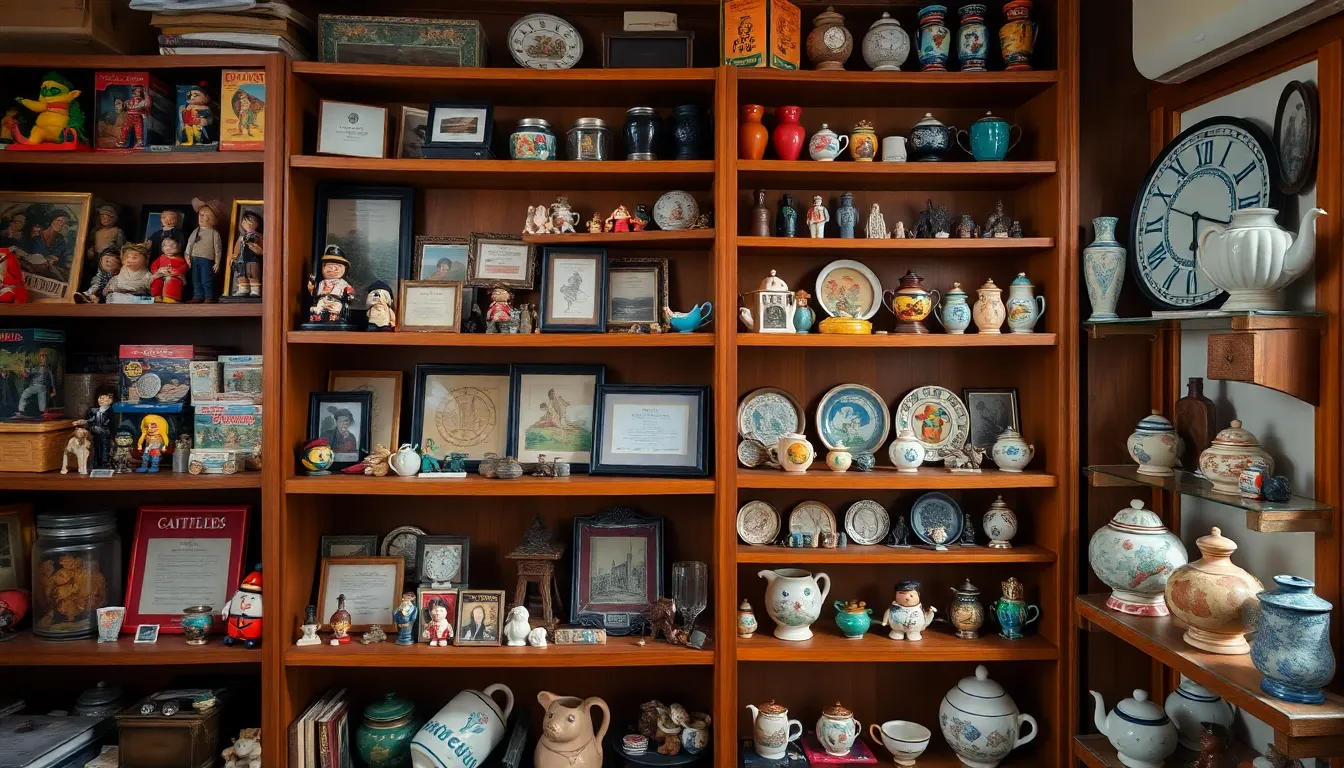Collecting is more than just a hobby; it’s a thrilling adventure filled with hidden treasures and nostalgia. Whether it’s vintage toys, rare coins, or quirky memorabilia, every collector knows the joy of finding that perfect piece. But let’s face it—after a while, those prized possessions can turn into a chaotic mess that rivals a toddler’s playroom.
Table of Contents
ToggleImportance Of Organizing Collectibles
Collectibles deserve a proper system for several reasons. First, organization enhances accessibility, allowing collectors to quickly locate specific items. Additionally, a well-organized collection can prevent damage or loss, preserving its overall value.
Orderliness contributes to the enjoyment of the hobby. When items are systematically arranged, collectors experience pride in showcasing their collections. Furthermore, it facilitates better management of space, ensuring efficient use of display areas.
Value assessments benefit from organization. Collections that are sorted and categorized provide clearer insight into their worth. Accurate records of items aid in determining market value, which is crucial for insuring collections or considering sales.
Another significant factor is the ease of inventory management. A detailed catalog simplifies tracking new acquisitions and unexpected trades or sales. It proves essential in case of theft or loss, offering proof of ownership and value.
Networking opportunities arise through organized collections. Collectors frequently participate in events, and having an accessible, visually appealing display can attract like-minded individuals. Engaging with fellow enthusiasts becomes easier when the collection reflects thoughtfulness and care.
Organizing collectibles also encourages expansion. Discovering gaps in a carefully curated collection motivates collectors to seek rare or valuable items. In turn, this pursuit can lead to increased knowledge about the items themselves and their historical significance.
Strategic organization supports emotional connections. When a collector remembers the story behind each piece, it transforms their collection into much more than a mere assortment of items. Overall, the importance of organizing collectibles lies in enhancing enjoyment, maintaining value, and fostering connections within the collecting community.
Benefits Of Organizing Your Collection

Organizing a collection offers several key advantages. Collectors gain clarity, enjoyment, and potential value increases through effective organization.
Increased Value
An organized collection often demonstrates higher value. Collectors uncover the worth of individual items more easily when categories feature clear labels and accessible displays. Market trends affect values, and an organized approach facilitates timely evaluations. Documenting provenance and condition maintains authenticity, which many buyers prioritize. Condition reporting and presentation impact selling strategies significantly. Inventory tracking allows collectors to make informed decisions about sales, trades, or acquisitions while keeping track of investments. Overall, a well-organized collection increases its market appeal and provides clarity during negotiations.
Enhanced Enjoyment
Enhanced enjoyment arises from an organized collection. Collectors experience less stress and greater ease when accessing items for display or sharing. A tidy arrangement encourages exploration of the collection, leading to rediscoveries of forgotten treasures. Sharing with fellow enthusiasts becomes more fun when organization highlights key pieces. Creating designated spaces fosters personal connections and storytelling opportunities, deepening emotional attachments. Enjoyment stems from the ability to appreciate the collection’s growth and diversity. Regularly engaging with the display can inspire future collecting goals, keeping passion for the hobby alive.
Methods To Organize Collectibles
Organizing collectibles requires thoughtful methods that enhance accessibility and enjoyment. These methods include categorization techniques and storage solutions, each serving a specific purpose in maintaining a well-organized collection.
Categorization Techniques
Utilizing categorization techniques simplifies organization. Grouping items by type, such as vintage toys or rare coins, allows collectors to locate pieces quickly. Organizing by theme, such as a specific decade or manufacturer, brings a narrative to the collection. Emphasizing condition and rarity helps prioritize valuable items within the collection. Labeling shelves or bins provides clear identification, preventing mix-ups. Maintaining an inventory list, detailing each item’s provenance and value, improves tracking of notable pieces. These techniques enhance overall enjoyment by creating a more engaging experience for collectors.
Storage Solutions
Effective storage solutions protect collectibles and maximize available space. Utilizing acid-free boxes prevents damage to paper items and photographs from moisture and acids. Display cases for fragile items provide visibility while ensuring safety. Using shelving units keeps items organized and accessible, reducing clutter. Employing climate-controlled storage for sensitive collectibles maintains their condition over time. Wrapping delicate pieces in bubble wrap ensures protection during handling and transport. Prioritizing proper storage aids in preserving the value and integrity of a collection while making items easy to enjoy and showcase.
Tools And Resources For Organizing
Utilizing effective tools and resources greatly assists in organizing collectibles. Digital solutions streamline inventory management, while physical supplies enhance preservation.
Digital Tools
Digital tools transform how collectors manage their collections. Software options like Collectorz and Sortly provide inventory tracking and categorization features. Mobile apps enable on-the-go access, simplifying updates and monitoring. These platforms often support barcode scanning for quick entry and retrieval of item information. Cloud storage ensures safe backups of data, safeguarding against loss. Integration with social media platforms fosters community connections, allowing for easy sharing and discussions about collectibles.
Physical Supplies
Physical supplies play a crucial role in preserving the condition of collectibles. Acid-free boxes safeguard against deterioration while offering convenient storage solutions. Shelving units provide visible displays, making it easy to appreciate and access items. Labels help categorize and identify pieces clearly, enhancing organization. Wrapping materials like bubble wrap protect fragile items during storage or transport. Finally, climate-controlled containers maintain appropriate temperature and humidity levels, preventing damage from environmental factors.
Tips For Maintaining Your Collection
Proper maintenance of a collection keeps items in their best condition. Regularly clean collectibles with appropriate materials to prevent dust accumulation. Using microfiber cloths works well for delicate surfaces. Avoid exposing items to direct sunlight, which can fade colors and cause damage over time.
Store collectibles in a climate-controlled environment. High humidity can lead to mold growth, while low humidity may cause items to crack. Acid-free materials, such as boxes and sleeves, provide essential protection against environmental factors. Positioning items in display cases offers visibility while shielding them from dust and physical contact.
Labeling items clearly assists in tracking and managing the collection. Describing the origin, date, and condition enhances inventory accuracy. Regularly updating the inventory list with any new acquisitions maintains organization. Keeping detailed records also aids in assessing the collection’s overall value.
Connecting with fellow collectors expands knowledge and resources. Joining online forums or local clubs fosters sharing experiences and tips. Participating in trade shows or auctions provides opportunities to discover valuable items and expand the collection.
Investing in cataloging software enhances management. Programs like Collectorz enable easy access to item details and quick search capabilities. Storing data in the cloud ensures safety and accessibility across devices.
Reviewing the collection periodically identifies items needing repair or maintenance. If any damage occurs, seek professional restoration services to preserve items’ integrity. Prioritizing preservation techniques leads to a well-maintained collection that continues to bring joy and appreciation over time.
Organizing collectibles isn’t just about aesthetics; it’s about enhancing the entire collecting experience. A well-structured collection allows collectors to appreciate their items more fully while ensuring their value is preserved. By implementing effective categorization and storage techniques, collectors can protect their treasures and create a more enjoyable environment for exploration and sharing.
Utilizing digital tools and maintaining regular upkeep further solidifies the connection to each piece, fostering a deeper appreciation for the collection as a whole. Ultimately, an organized collection not only safeguards items but also enriches the journey of collecting, paving the way for future discoveries and connections within the community.


